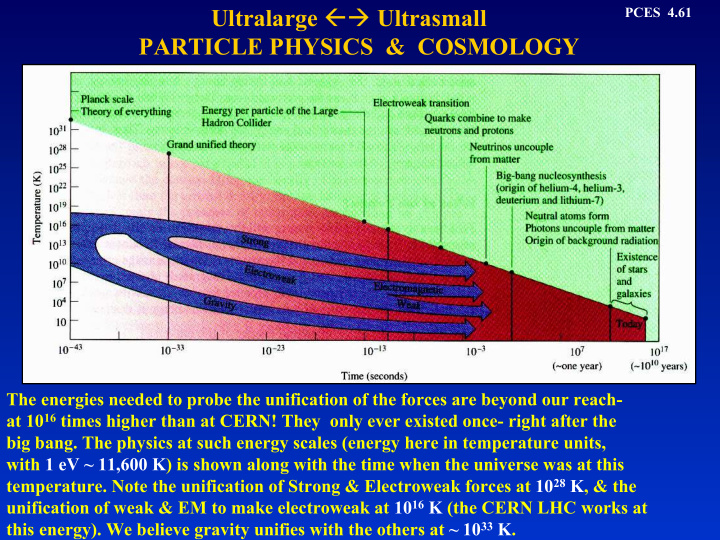



Ultralarge �� Ultrasmall PCES 4.61 PARTICLE PHYSICS & COSMOLOGY The energies needed to probe the unification of the forces are beyond our reach- at 10 16 times higher than at CERN! They only ever existed once- right after the big bang. The physics at such energy scales (energy here in temperature units, with 1 eV ~ 11,600 K) is shown along with the time when the universe was at this temperature. Note the unification of Strong & Electroweak forces at 10 28 K, & the unification of weak & EM to make electroweak at 10 16 K (the CERN LHC works at this energy). We believe gravity unifies with the others at ~ 10 33 K.
PCES 4.62 Early Moments of the Universe LEFT: a variety of Universes RIGHT: COBE map anisotropic µ wave background We now believe the early stages of the universe had a period of very rapid expansion (inflation), followed by a slower uniform expansion- according to recent evidence now slowly accelerating. Understanding of the very early moments comes from measurements of tiny fluctuations in intensity of the microwave background, left over from the big bang. These fluctuations later self-gravitated into galaxies. The inflation scenario explains the small size of these fluctuations (a fraction ~ 10 -5 of the total µ wave background). FAR LEFT: Use of supernovae to follow expansion of universe NEAR LEFT: new galaxies in HST deep field photo
PCES 4.63 Cosmic Distance Scales Measuring large distances is complex. Cepheids play a crucial role- these giant pulsating stars have pulsation time simply related to their luminosity. They can be seen out to ~ 10 8 light yrs with ABOVE: Close-up of NGC 4603- some NGC 4603, @ 108 million lt. yrs Cepheids are identified in boxes modern telescopes- we know their real luminosity because some Cepheids are near enough to have their distances measured in other ways (parallax, etc). At much greater distances one relies on supernovae, whose luminosity is known fairly accurately from their spectra. These are so bright they can be seen as far as the farthest galaxies. From all this work we find that the radius of the visible universe is ~ 14 billion (1.4 x 10 10 ) light years, & the age of the universe is ~ 1.4 x 10 10 yrs LEFT: Supernova in HST deep field- note difference between 1996-7.
PCES 4.64 Seeing to the Edge of the Universe The 2 main tools giving us our understanding of the early universe are (i) powerful earth-based radio telescopes, and (ii) optical telescopes, principally the Hubble Space Telescope (HST). Although the HST mirror is only 2.5 m in diameter, there is no atmospheric interference, and it can take week-long exposures. Radio telescope arrays connect dishes far apart, giving v high resolution. Orbiting telescopes are also designed to see in the The HST (above) & its launch IR, UV, X-rays, and Gamma rays (none of which (below right) penetrate the atmosphere). LEFT: The Cos-B satellite under construction. It carries The VLA (Very Large Array), a set of 26 dishes, a gamma-ray telescope each of 25 m, which can be moved along rails stretching 15 miles from the centre
Recommend
More recommend